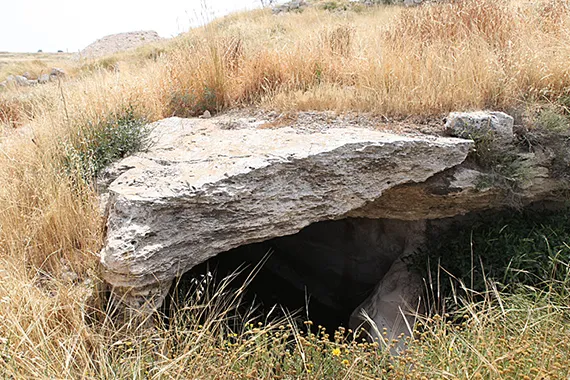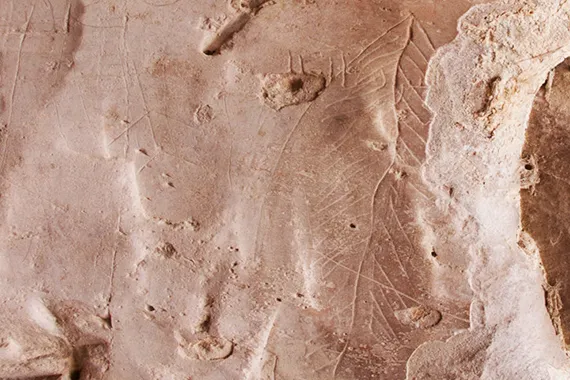
Subterranean Chapel
A small subterranean chapel was discovered west of the large columbarium and northeast of the basilica church. Since the structure was built underground, it was most likely constructed by early Christians during the period of Christian persecution; before Christianity was acceptable by the Roman Empire. The space is entirely rock hewn. Four steps descended to the main chamber which is separated from the apse (a semi-circular or polygonal section of a church, almost always on the east); by a 1.3-foot-high enclosure wall with an opening in its center, meant to mimic a chancel screen. A rough square-shaped protrusion was left in the center of the floor, and is probably the remains of an altar table.
A number of niches were found in the chapel walls, apparently meant for oil lamps or for the placing of ritual items. Also seen on the walls are incised graffiti, comprising several Greek Christian crosses, a fish bone, and possibly the Greek letter Lambda (Λ) or Alpha (A) enclosed in a frame, all symbols of Christ believers. The clear axial orientation of the chapel, the stairs, and the apse enclosure wall are all indications that great thought and planning were put into the chapel’s construction.
During the period of persecutions of the Christians, believers did not openly use the symbol of a cross on monuments and sepulchers. The symbols of Christianity were usually disguised as an anchor, a trident, or the mainmast of a ship. When a cross was used it consisted of equilateral arms and became known as a Greek Cross (+). Several variations of the Greek Cross emerged, including the 3 prongs at the end of the arms of the Greek cross symbolizing the Trinity as seen on the wall of this subterranean chapel. Much later, after Emperor Constantine legalized Christianity in 313 AD, did Christians begin using the crucifix as a symbol of their Christian faith.
Video
Video Transcript
The subterranean chapel is a small chapel that was hewn in a cave and faces to the east like most of the chapels and Christian churches in the Byzantine period in Israel. It dates to the middle of the fifth century C.E., which means that it’s prior to the main Byzantine church that we found at the site. The subterranean chapel is divided into two sections. The apse faces to the east and is divided by a chancel screen from the main hall, in which we’ve found the base of an altar. On the walls we found Christian symbols and monograms like crosses and the fish bone, which symbolizes Jesus.
Virtual Tour
The virtual tour for this location works on your computer web browser as well as a tablet or a phone. Best of all, it works on your headset. For instructions using an Oculus Quest, please see our virtual visit page.
Image Gallery




